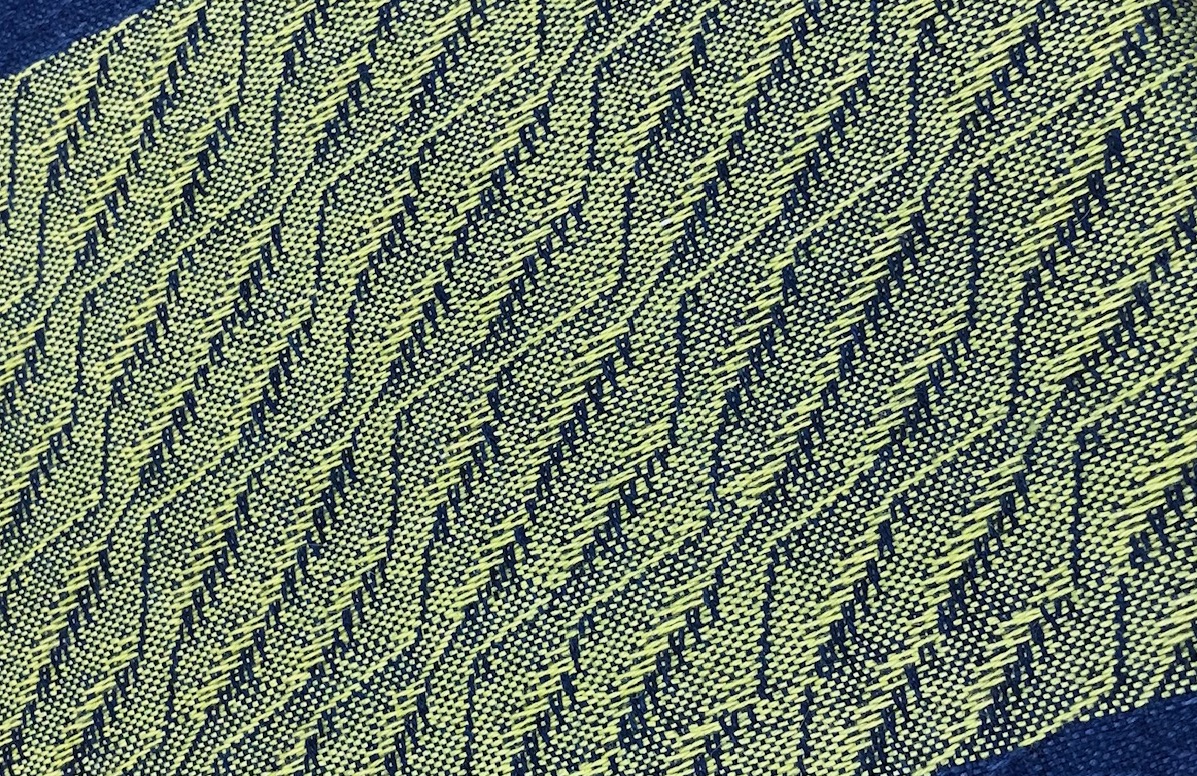
Episode #59
Jo Andrews
You may not have heard of Kantamanto market, but it plays a vital role in dealing with the world’s textile excess. This is where many of the clothes we donate to charity shops, goodwill centres, or put in textile bins end up. The west African market takes bales of second-hand clothing from all over the world and does its best to recycle them. But what can’t be used is dumped at informal waste sites or burned, causing mounting environmental problems in Accra’s streets and on Ghana’s beautiful beaches.
This episode of Haptic and Hue’s Tales of Textiles looks at the ingenuity of Kantamanto and the growing tragedy and tracks the global cost of fast fashion and textile excess. It takes a hard look at the possibilities behind new recycling technologies, and it asks how we, as consumers, can tackle our textile waste.
Notes:
The Or Foundation’s Website is at https://theor.org/ and you can find them on Instagram at https://www.instagram.com/theorispresent/
The paper that Lisa Macintyre co-authored is called Textile Recycling and Recovery: An Eco-friendly Perspective on Textile and Garment and Industries Challenges. It is free to access and you can find it at: https://journals.sagepub.com/doi/full/10.1177/00405175241247806
The Guardian has published a good article about the problems of textile recycling at charity and thrift shops. https://www.theguardian.com/environment/2025/apr/29/you-sold-it-now-recycle-it-the-protesters-mailing-worn-out-clothes-to-the-shops-they-bought-them-from
There are lots of books about textile recycling and over-production. Two that I like are Clothing Poverty: The Hidden World of Fast Fashion and Second Hand Clothes by Andrew Brooks, which is in the UK Haptic and Hue Bookshop and the US Haptic & Hue Bookshop and also Unravelled by Maxine Bedat, again in the Haptic & Hue, UK Bookshop and in the Haptic & Hue US Bookshop.

Kantamanto Market During the Fire, photographed by Julius Tornyi, The Or Foundation

The Market Ablaze, photographed by Julius Tornyi, The Or Foundation
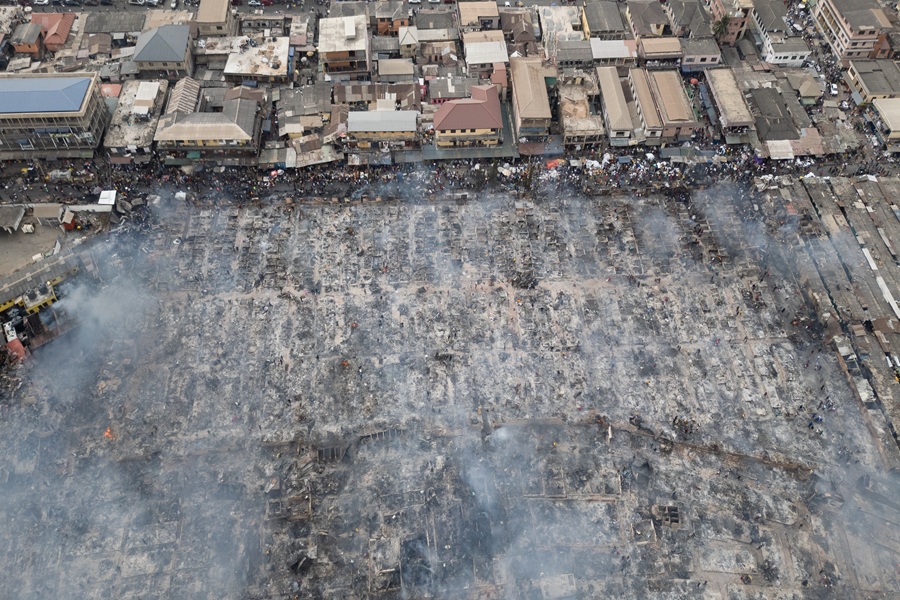
Aerial View of the Damage Kantamanto Market, photographed by Julius Tornyi, The Or Foundation
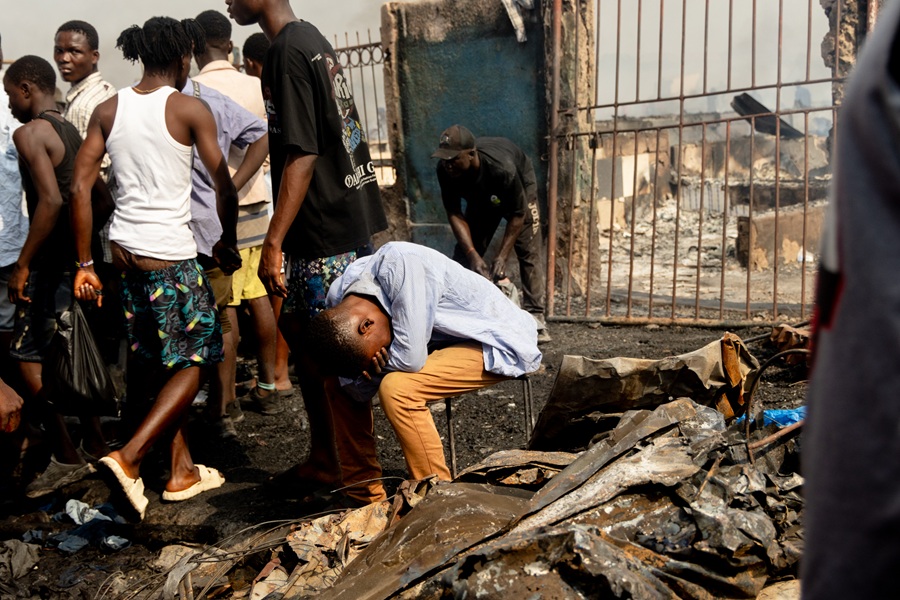
A Stall Owner Grieving, photo Tonia Marie Parker, The Or Foundation
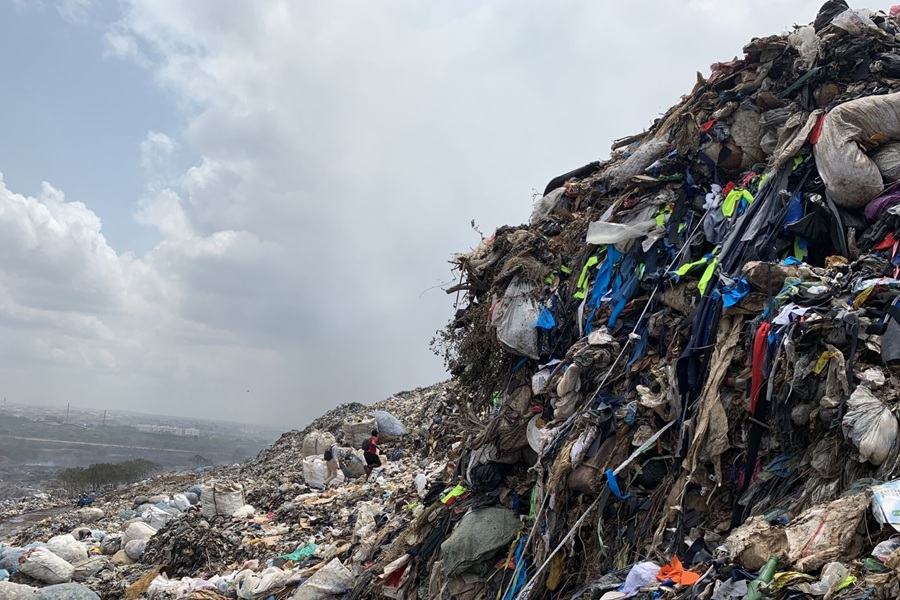
Dump in Ghana

The Or Foundation Cleans the Beach

Textiles Forming Matted Clumps, photo from The Or Foundation
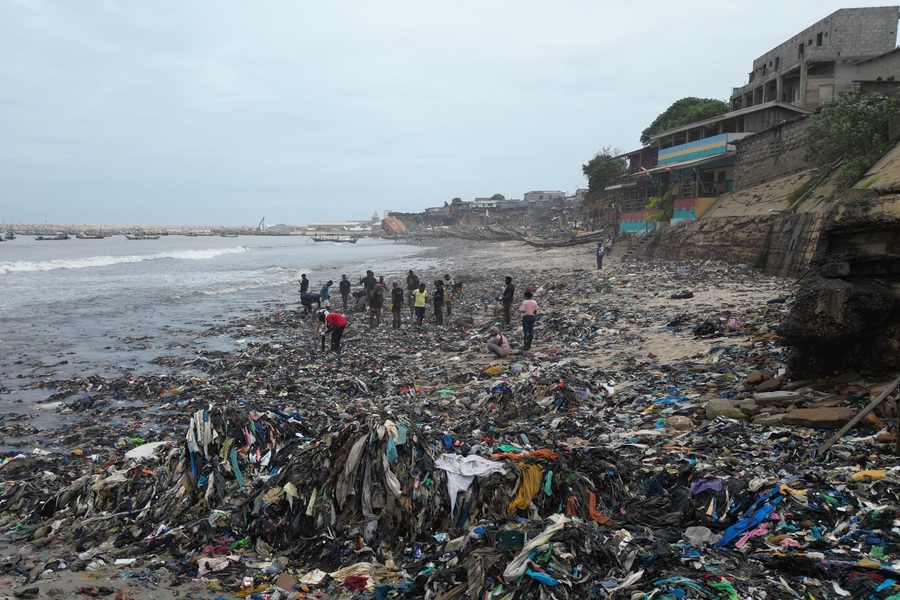
Jamestown Beach, Accra, Ghana, Cleanup. The Or Foundation

Holly

Bushira and Rukaya Abubakar
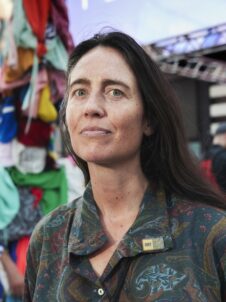
Liz Ricketts, CEO of The Or Foundation

Lisa Macintyre, Heriot Watt University.
Script
Textile Waste and the Catastrophe at Kantamanto
JA: Late at night on New Year’s Day as the world was winding down from celebrating the arrival of 2025, a disastrous fire broke out at the biggest second-hand clothes market on the face of the planet. The flames quickly ripped through Kantamanto Market in Ghana, West Africa:
Liz Ricketts: Our team was getting calls by around midnight and was at the site by like 1:30 AM on the 2nd. And unfortunately, I mean, this is the biggest fire that the market has seen. This fire impacted 10 out of the 13 sections. So, it destroyed about 60% of the retailer side of the market. And that’s has directly impacted over 10,000 individuals. So that’s primarily stall holders, second hand retailers, the people who work for them, security and women working head carrying, working as kayayei, as well as tailors and some upcyclers.
JA: That’s Liz Ricketts, Co-founder of The Or Foundation, an NGO that works in solidarity with the people of the Kantamanto Market. You may not have heard of the market – but your clothes have. It’s likely that one way or another clothing or shoes that we have worn has ended up there. If you have ever given clothes away to charity or goodwill shops, donated to jumble sales or put them in a textile bin there is a high probability they will have found their way to Kantamanto. The Market is the beating heart of the world’s clothing re-use industry and its a vital part of the hidden world of what really happens to the billions of tonnes of clothing we discard every year. But it’s become a fragile link in a chain that is breaking apart under the intense pressure of fast fashion – the ever increasing amounts of clothing and textiles that we produce and dump year on year in countries like Ghana.
Welcome to Haptic and Hue’s Tales of Textiles. I’m Jo Andrews a handweaver interested in what textiles can tell us about ourselves and our communities. For years I’ve been following what really happens to old clothes and horrified, without really understanding it, by the excesses of fast fashion. This episode is an attempt to unravel some of the big questions of our age around textile over-abundance. How much does it contribute to global pollution and the consumption of resources? And can we really smart our way out of this, will technology and textile recycling come our rescue? But to understand this, first we need to go back to the fire at the Kantamanto Market. One of the people who lost her stall and all the goods she had there was Rukaya Abubakar:
Rukaya: It has really affected us. It has really affected because all the shops, all the shops there are burnt, all the shops. And we just brought the things. Most of us just travel to bring the goods when it happened. So, it really affected, really affected us. So we lost everything. We lost everything.
JA: Rukaya’s sister, Bushira, is a friend of mine and she was in daily contact with her sister:
Bushira: So, she said some people have been paralyzed due to that from the shock. Some are in the psychiatric hospital because they really can’t take it, you know, they couldn’t handle it properly. Others have even died due to that and have lost so much. They’ve lost everything. And she also stated that because some of them went in for loans and some had their suppliers bringing them, and then they, them paying later. Now they don’t know what else to do. How are they going to raise the amount of money? Because these people have, they are written assets, if I can put it that way. You know, they have like the things, there are lots of money and if everything is gone and most of it is taken from a supplier, how then do I get the cash to pay you back if I haven’t sold anything? So that was what she was talking about.
Jo: And people depend on those stalls for their livelihood, don’t they?
Bushira: Yes. Oh, I, I can say that like 85% of the women working there do that on their own, no help from anywhere. And the young men who are also there, and even older men who are there is, is like, that is their last stop. They have nowhere else that is the source of their livelihoods.
Jo: What kind of people are they supporting?
Bushira: Their families, their children mainly. But there was a video of this woman that I saw saying that she had just gone for a loan and she she’s got a son in school and now that everything is gone, how is she going to support him because there is no father, there is nobody else apart from her. You know? So that, that was very hard to, to watch and listen to.
JA: At present no-one knows what caused the fire. It might have been food vendors cooking over an open flame or possibly a firework that went astray. There will be an official report from Ghana’s Fire Service but the market leaders and organisers, with the support of the Or Foundation, have been rebuilding and reorganising, installing better fire precautions and addressing the safety of the electrical system, but the market is huge. Here’s Liz Ricketts:
Liz: So the market sits on around 18 acres and there’s an importer side to the market and there’s a retailer side to the market, and the retailer side to the market is the biggest in the world. There’s 30,000 people who work there. There are about 15 million garments that flow through this market every single week. And some of those garments will make their way to surrounding countries or other places in Ghana, but most of them will be recirculated within this market through resale, repair, upcycling or at least the attempt to, to do so. And it’s an incredible place. I mean, it’s my favourite place on the planet. It’s why I do this work. I mean the, the skillset and the creativity, you know, the ability for people to take basically a minimum of 25 million garments every month and find a new home for them while also adding a lot of value, whether that’s on like a small scale, like a tailor customizing, you know, kind of frankensteining and customizing an outfit for an individual. Or there’s tailors, you know, that are making a 100, 150 items a day. So for instance, taking men’s shirts and turning them into boxers for kids. And they’re doing this with a waste stream that they have no control over. I mean, it’s incredible. There’s this energy of just like possibility.
JA: And that’s the good side of what Kanatamanto does – it takes the discarded clothing of other countries around the world and applying skill and creativity – reuses literally billions of tonnes of our waste. Until around 10-15 years ago this was a roughly sustainable model where garments were usefully diverted from landfill and had value, but then fast fashion began to arrive.
Liz: We didn’t start the Or Foundation because of textile waste. We started it because we were inspired by the bespoke tailoring culture of Ghana and wanting to connect people in America, where there’s no longer really this sustainability language, to a culture and community of people here in Ghana that still speak that language. But basically between 2011 and 2016, we started to see more and more waste. And we started to see this vibrancy of the market really being impacted by fast fashion where a lot of retailers started telling us, you know, that they no longer really felt that there was dignity in their work. And the biggest red flag was that they didn’t want their kids to take over their business anymore. We started hearing that in like 2014, 2015, and that’s a sign that this market is headed towards collapse, right? Because this is a traditionally a family business and people were no longer making money. There was no longer enough good quality clothing to basically subsidize the rehabilitation of the lower quality stuff. And so the cooperation that used to exist across the market where a retailer would have the funding to take a lower quality item and take it to a dyer and have it dyed or to a seamstresses and like custom make something and then resell it, they don’t have a lot of those financial resources anymore because the quality of the clothing has gone down so much and the value of the clothing has gone down so much while their operating expenses have gone up. And so that’s led to a lot of waste. It’s led to a lot of debt. And so unfortunately some of that kind of like collaborative spirit within the market has disappeared. It’s still there. But it doesn’t function to the degree that it, it did when I first went to Kantamanto in 2011.
JA: The deluge of foreign made clothes streaming into the Market means there is no energy left over for local clothing:
Liz: But no one in Ghana can take their own clothes from their own closet and take it to Kantamanto to be resold, repaired or upcycled because that market has been dominated by foreign clothes to the point where all of the skillset, all of the energy, all of the creativity that is there is being applied exclusively to solve a foreign problem with no access for local <laugh> recirculation. And for me, that’s where like we know something is wrong, right?
JA: And the other big problem is that Kantamanto simply can’t digest all the clothing that is pouring into it, which means that clumps of rotting clothing litter the once beautiful beaches of Accra:
Liz: Yeah, it’s, it’s horrible. We have a clean up tomorrow. Our team removes like 20 tons. It’s over that now. I was looking at the last week we did almost 40 tons, but 20 up to, or at least 20 tons of textile and plastic waste from the beach every single week. And every single week it is replenished <laugh>. So again, this is where we have to look at the root cause of overproduction. Like I’m very proud of the work that we do. We’re developing new materials, you know, we’re helping people create new jobs, finding new retail opportunities, doing these clean ups. I’m very proud of the work that we do. I’m proud of our team, but like, I’m not delusional. Like we cannot, we cannot solve this problem if it is just going to replenish itself, right? Like there has to be a focus on the root issue.
JA: Liz and her team make sure that the dumped clothing they collect is taken to a controlled dump but it’s not ideal:
Liz: So, the landfill, the one sanitary landfill that Accra had access to exploded in August of 2019. Yeah, it was bad. I was there the day that it happened to meet with some, a waste picker collective. And yeah, so there’s no, there’s no access to a sanitary landfill or to an incinerator in Accra. So the best we can do is kind of take the waste to a controlled dump site about like an hour to two hours outside of the city which is limiting because if we can only take like one truck a day, then it limits how much we can collect from the market before it enters the environment.
JA: Liz is very clear that Fast Fashion is at the root of Kantamanto’s problems:
Liz: I don’t I know for some people that feels very undefined, but for me, fast fashion is simple. It’s a volumes over value business model. Over production from my perspective is not an accident. It is a very intentional business model that involves exploiting everyone along the value chain. I mean, there overproduction is only profitable to the degree that it is. I mean, you have some of the richest individuals in the world are the founders of these fast fashion companies, right? It’s only profitable to the extent that it is if garment workers are exploited, if the true cost of materials is not accounted for. So you have all of these sort of irresponsible decisions that have been made along the value chain. And what happens is that, people are buying a $20 garment, maybe a $10 garment, something that’s as cheap as like a nice cup of coffee or a sandwich <laugh>, and they don’t see value in it anymore, right? So, you know, someone in, in the UK, if you buy something for 10 pounds, like are you going to take the time to repair a button once that breaks, right? Like, why, why would you do that? It’s probably an easier use of your time to go out. And so people are literally throwing away money and they’re throwing away their clothes. And so there’s no longer enough embedded value in clothing to subsidize or sustain this global circular economy or this global second hand trade, right? I mean, how does a $10 garment new subsidize the collection, sorting, repair, preparation for export, export the imports, the further sorting, the preparation for resale repair over dyed et cetera, like $10 cannot do that. So the community in Kantamanto again, is, is shouldering the burden of all of these irresponsible choices that have been made without being given access to even understanding that.
JA: She says that most of the people at Kantamanto don’t have the opportunity to understand the system they are part of:
Liz: But most of the people that we have the privilege of working with in Kantamanto, they might have never left Ghana. They don’t know that there are like CEOs in Europe making billions of dollars off of this business model of overproduction, right? So they’re just holding psychologically, they’re holding all of this and they feel like it’s their fault. You know, and I didn’t fully realize this until we started taking delegations outside of Ghana. We took our first delegation to Paris in 2022, I think. And the retailers from Kantamanto went into the fast fashion stores and they were looking at, you know, like the seams <laugh>, everyone here in Ghana is very discerning when it comes to the quality of clothing, because everyone grows up sewing still. So, they were opening <laugh>, really like inspecting, and they walked out of the store and said, you know, that store is full of Borla, which is a term that means trash. And then they said like, what chance do we have? You know, and we got back to Ghana to Kantamanto. And they called for a meeting after the trip and they said, you know, one of the things that we realized on the trip is that we no longer are going to make this our fault. Like they said, we’re no longer going to show up at five o’clock in the morning and work until six and get home at nine and sacrifice time with our kids because we now realize that we can’t solve this problem by just us working harder., it made me realize they carry all of that, you know, because they aren’t given access to this full picture, they’ve assumed that like this waste is, is their fault. And that’s so horrible. And so if you think about something like the fire happening again, the emotional distress and kind of people just feeling like they’re on their own, it’s just, it’s tragic. I mean, it’s horrible.
JA: It seems also true that those right at the other end of the system, the purchasers of cheap ever-changing fashion, also don’t have the full picture of what they are taking part in. I am no help here – I go months without buying anything new and my clothes last for years. But let me introduce you to Holly recently graduated from university in the UK, and while she is an exemplary dresser – she buys her clothes second hand – she’s a keen observer of her generation:
Holly: So it would be very common to order one to two big orders a week. Whether it’s like a hundred pound Shein Haul or yeah. Each week specifically girls in my knowledge would order a large amount of cheap clothing from Shein. And, you know, you film yourself doing a hall, so you’ll try on all the different pieces and you’ll show what you will keep, what you don’t like. And oftentimes what you don’t like, you have the option to return, but quite commonly you miss the return window or you just don’t get round to it, or you can’t be bothered to go through the process of returning it. So it sits in the bag of clothes that you’ve been meaning to get rid of.
JA: Shein is a fast fashion company and a haul is ordering a large amount of clothing often with free postage, but what’s the point of ordering clothes you don’t want?
Holly: I think that social media has really had a huge impact on trends and on micro trends and on encouraging us to consume at a level that we haven’t before. So, you know, you’ll see influencers or people you follow or people you admire with a new outfit, a new style. They’re trying out something different and you know, that encourages you to go and buy. And I think the difference is that those trends change so quickly and these micro trends change. So I think that social media has a huge impact on how much we are buying and how quickly that changes and how quickly you no longer have use for your clothing.
Jo: And is that why your fellow students were doing this?
Holly: Yeah, I think so. I think that especially at Uni, but as a teenager, really, I think that your clothing and your fashion becomes a huge part of how you present yourself and a huge part of who you are. And a lot of people will move to Uni with like a, okay, I’m gonna reinvent myself a bit. There’s no one here that I know, you know, I want people to like me. I want people to think I’m cool and your clothing is a huge part of that. So, if you are, you know, seen to be wearing the same thing too many times, I think it’s coming back into, back into popularity to be an outfit repeater. But there was a period of time when I was growing up where that was like a, an insult where if you wore the same thing too many times, you weren’t fashionable, you weren’t stylish, you didn’t have enough clothes, that kind of thing.
Jo:Can you just explain what an outfit repeater is?
Holly: <Laugh>, of course. It’s literally someone who wears the same outfit more than once. it got to the point where it was so common to buy an outfit just to wear once, that if you didn’t do that, you were considered an outfit repeater, which is wild as a concept.
Jo: And this was a term of insult?
Holly: Yeah, yeah, definitely. And yeah, I think now there are more people willing to claim the fact that they’re outfit repeaters and they can be proud of it. And I think it’s slightly changed, but at one point, yeah, it was absolutely an insult.
JA: This was all big news to me. But the other thing that confused me and yes, I know I’m generations away from Holly, is how could students afford to order a mass of clothing once a week? Holly says it partly depends on their background BUT……
Holly: And you know, there are also things nowadays like Klarna, have you heard of? Klarna basically means that you can pay in instalments for your clothing orders. So if you buy a large order on a clothing website, you can split that into instalments monthly, it can be like five pounds a month for the next however many months, or three pounds a month, three pounds a week. But things like that mean that, you know, if your student loan comes in, you can use that for certain new clothes if you are working a part-time job, you can use that for some new clothes. I think that for students, your sense of fashion is evolving so quickly at that age that that becomes a really important, that consuming becomes a really important part of your identity, I don’t think that people have enough time to make it as circular as it should be or not have enough time, but aren’t as conscious of that or it’s not a priority.
JA: Its possible – especially given the shock of recent events that we may look back on the experience of Holly’s generation as something bizarre and extraordinary – but the difficult truth is that our consumption of textiles and clothing continues to rise exponentially year on year:
Lisa MacIntyre: Current estimates are a hundred billion garments being manufactured every year globally, but that is a guesstimate. What we can see is that the, the graphs for textile production and the graphs for garment production are increasing. It’s not a straight line of increasing. It’s a curve going accelerating
JA: Lisa Macintyre is Associate Professor in the School of Textiles and Design at Heriot Watt University in Scotland.
Lisa: The problem is getting bigger because we keep producing more garments. so we’ve been talking for a long time about reducing our carbon emissions, about reducing our volume of production, but every year we increase them and the technological advances in making technologies more efficient are far out stripped by our overproduction and over consumption of garments.
JA: Lisa and a number of others have written a great paper that sets out the possibilities and reach of current textile recycling. Have a read if you are interested in the subject. I’ve put a link to it on the Haptic & Hue webpage for this episode. In it they detail just how damaging our current level of textile over production is: its responsible for about 10-12% of global carbon emissions, large amounts of energy consumption and it is one of the world’s biggest consumers of water and producers of water pollution:
Lisa: We use about 18,000 different chemicals to produce textiles. Some of which are banned, some of which are very harmful but not banned, and some of which are much more benign and, and not necessarily particularly harmful, but 18,000 different chemicals. At no point does anybody in that system know exactly what they are. They wash off our textiles and therefore end up in our waterways. And therefore, pollute rivers and the marine environment. In countries like ours where we have really strong environmental legislation we have reversed a lot of the damage that we were doing in the 1940s and 50s where we were pumping all this effluent out into the rivers. But in countries without such strong environmental legislation, all of the chemicals that are put onto textiles, some of that will end up in effluent that is washed off the textiles, and that goes straight into the waterways and therefore you end up with dead rivers. There is overconsumption of water in countries where water is scarce because things like cottons are very thirsty plant. You have to irrigate the cotton in order to get a good harvest. So you’re taking water in a country where water is not massively readily available and you’re pouring it on crops rather than giving it to people to drink.
JA: And then on top of all this we simply can’t get dispose of everything we make. The most interesting part of the paper Lisa co-wrote deals very clearly with textile recycling. I realised reading it I’ve been pretty confused about this but Lisa sets out the different types very clearly.
Lisa: Okay. So, they’re used interchangeably in the literature sometimes, which can make the literature very confusing. But the best of them is reuse, because that requires no additional energy. It just means you’re taking a garment that already exists and you’re reusing it, somebody else is reusing it, or you’re reusing it for a slightly different purpose. The next best is closed loop recycling, and that means that you’re taking an item and you’re turning it back into a similar item of similar value. So, textile to textile recycling would be classed as closed loop, but is vanishingly rare. The next one is open loop recycling, which means you’re taking a textile material and you’re turning it into a different product. Normally a product of lower quality, so maybe you’re taking a t-shirt and you’re cutting it up and you’re using it for cloths. That would be open loop recycling. And then energy recovery is you’re burning it and you’re trying to reclaim some energy. People do talk about that as recycling, but I really think that’s taking it very, very far.
JA: So, the most efficient kind of recycling and the commonest is re-use – that’s the gold standard and exactly what Kantamanto Market does.
Lisa: So that is the priority of everybody who’s collecting textiles for recycling. Mostly they’re collecting them for reuse. So sorting facilities are, are first separating off anything that they can reuse without any kind of mechanical or chemical process. All of the numbers that are going around in the literature are all estimates slash guesstimates. But the literature says that between 25 and 35% of textiles are separately collected. So not thrown in a general waste bin, but collected separately. So, if about a third of textiles are separately collected, about 50% of that is then reused or is sorted for reuse, which is not necessarily the same thing <laugh>. It means it’s either sent to a charity shop or it’s sent overseas where we hope that somebody will reuse it. But we send far more stuff overseas for reuse than is ever actually reused because they don’t like rubbish quality garments any more than we do.
JA: So, on best guesstimates about 15% of garments possibly get re-used.
Lisa: And then we come to the open and closed loop recycling. So that’s somewhere around about three to 4% of all textiles potentially according to people’s estimates are recycled in some form. So, the textile is unmade and then remade into something else, but almost all of that is down cycling into cleaning cloths, into low value carpet or insulation or something of a, of a low order. But that still is better than not using it because it means that you’re not taking virgin resource, virgin fibre and reusing it for a low value product. So even though it’s not, the gold standard, it’s still better than not doing it. And a vanishingly small proportion of textiles are fibre to fibre recycled. And the current best estimate, which is somebody’s guess at a cocktail party no less, is less than 0.1% of separately collected textiles are turned into new textiles and re-enter the clothing cycle. The vast majority of so-called recycled textile materials that we have are made from, its polyester and its plastic bottles. Open loop recycled into textiles because plastic bottles are a higher grade of plastic than the plastic we use for clothing. So rather than turn those plastic bottles into new plastic recycled plastic bottles, they get higher value if they turn it into a polyester for textiles and make them into new leggings, for example.
JA: And lastly then there is incineration for energy, and then landfill, and at present there simply aren’t any figures out there but we must assume that of the remaining 70% of discarded textiles, some are incinerated, some go into landfill and rest is illegally dumped.
Lisa: There’s a whole lot of illegal dumping as well as the legal dumping. If you look at images of the Atacama Desert from space, you’ll see loads of textiles that were well-intentioned, sent overseas for reuse but that have then been dumped in the desert, rather than used for any separate purpose.
JA: And here’s the real kicker. Until now I naively thought that some form of recycling would come to our rescue, that we would with a little time be able to smart our way out of this crisis. Lisa is doubtful:
Lisa: I’m doing research on that at the moment and lots of other people are as well, and we are doing our best because we have a huge waste problem to deal with, and it would be better that it was recycled. But most forms of recycling end up with a product that is more expensive than the virgin product and a product that is probably not as good quality. And you’ve put in a whole load of energy and human resource to try and remake it. So, the recycling of textiles is never going to be as efficient as recycling of glass or tin, for example.
JA: She thinks we should still try to do it, but thinks it will be difficult for it to be properly commercial. And she also doesn’t think that any of the bright shiny experiments that seem to promise so much will come to our rescue any time soon:
Lisa: There are lab scale technologies that show that it is technically possible, but if you put, a hundred grams of polyester into even one of these lab scale recycling facilities, you did not get a hundred grams of polyester back out. And you also throw loads of energy and chemicals at that in the process. So, so recycling is a potential solution, but it’s always going to be expensive. It is always going to be expensive in financial terms, in labour terms, in chemical terms, and in energy terms, it’s going to produce CO2. And so it’s not, it’s not the perfect solution. I think that with a hundred billion garments going into the system every year, that hoping that 0.1% of 30% miraculously upscales is a very, very optimistic way of looking at it. Now, I, I am an optimist, but even for me, that’s a stretch.
JA: For me that’s incredibly important – what we need is not a magical new process but a simple old one: Lisa puts it bluntly.
Lisa: I think that we need to vastly reduce our consumption and I think that that should be our priority. Not hoping that technology saves us from our own reckless behaviour.
JA: Back at the Kantamanto Market in Ghana, Liz agrees:
Liz: And I don’t know why it’s so difficult for people to, to understand that because everyone who’s investing money in even, you know, like the most advanced fibre recycling, I’m sorry, but if we still are only recycling 1% of post-consumer waste, like what are we doing? Like all of the money, the millions and billions of dollars that are being invested in these like new high tech plants, that’s a waste of money if it’s going to continue to be buried underneath this oversupply of stuff. So that’s my way of saying like, there’s not an easy <laugh>. There’s really no good answer to that question until everyone gets on board with addressing this root cause and starts to again, reduce production volumes and displace the production of new products with upcycled and resold and repaired product.
JA: Textile waste is a real crisis and one that is getting worse every year, but somehow because it’s an enduring one it never seems to rise to the top of the pile, and until it’s us who drown in our own textile waste, rather than poorer countries that are out of sight, that’s unlikely to change, but what can change is our own behaviour and Lisa says slowly it is beginning to:
Lisa: I think that on the positive side, reuse is, is massively up and is also up amongst younger demographics. So, things like Vinted and Depop have massively increased the value of second hand garments and have converted quite a lot of people to using second hand in preference to cheaper quality fast fashion items. So, I see that as a huge positive and I expect that will continue to grow. I think that recycling technologies will come on board, but unless tax is applied to virgin quality materials and used to subsidize recycled materials, it’s going to be very hard to make that commercially viable.
JA: Lisa says she personally loves clothes and loves shopping but she has changed her behaviour since she started this research. She has come to understand that the order of the words Reduce, Reuse and Recycle is vitally important, reduce is the first priority, reuse the second and only then is recycling the third option. Lisa now repairs her own clothes, shares with others for special occasions and buys much less.
Lisa: And there’s a researcher called Kate Fletcher who it was a campaigner in the early days of, of talking about textile sustainability. And she suggests that we wear things for a minimum of 30 times. And I found that really helpful when I’m shopping because if I do go shopping and I go, oh, it’s gorgeous, it’s pretty must have it, then I think, am I really gonna wear that 30 times? And if the answer’s no, then I, I leave it behind. And if the answer’s yes, then I might allow myself to buy it. But that also really helps me with bargains because a bargain is not a bargain unless you’re actually going to use it. So again, I ask myself that question, am I going to use it 30 times? So that’s really helped me.
JA: And as the little stalls in Kantamanto begin to rebuild and recover from this latest disaster Liz says the people who work here and help to run the market deserve to be respected for what they do.
Liz: You start to look at clothing as if it is material that exists for you to co-create with, and everything starts to have this personal connection and memory to it. And I really wish that more people could experience that. And so for us, like we are just trying to do whatever we can to intervene to support this community because that’s what Kantamanto is. Kantamanto is a community first and foremost. You know, for me, Kanta is not defined by where the clothing comes from. It’s this incredible community <laugh> in this massive market with an incredible skillset that deserves to be respected and uplifted.
JA: Thank you for listening this month, a number of you have been asking for a new episode on textile waste and recycling for some time. I hope this fits the bill. I wanted to thank Pam Weeks, who promoted me once again to look seriously at recycling schemes. And of course I wanted to thank everyone who gave up their time and wisdom to take part in this podcast. Textile waste is a problem that isn’t going to go away and all of us will hear much more about it in the years to come.
If you would like to see pictures of Kantamanto Market and the once beautiful beaches in Ghana, or find the link for The Or Foundation’s work and the paper co-authored by Lisa Macintyre, head over to the www.hapticandhue.com/listen and look for Series Seven.
Haptic and Hue is hosted by me Jo Andrews. It is edited and produced by Bill Taylor and sound edited by Charles Lomas of Darkroom Productions. Haptic and Hue is an independent podcast free of ads and sponsorship, supported entirely by its listeners, who generously fund us through Buy Me a Coffee or by becoming a Friend of Haptic & Hue.
Friends get access to an extra podcast a month hosted by me and Bill Taylor and in the next episode of Friends we will be talking to Jess Bailey and Deb McGuire who have some great news about North Country whole piece quilts – but I’m not allowed to tell you exactly what that is until the podcast gets published next month!
To join Friends go to www.hapticandhue.com/join. But until then its good bye from me and enjoy whatever you are making.

